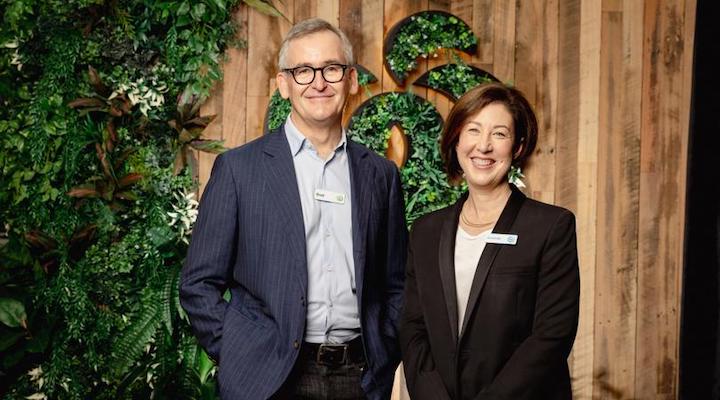The appointment of Amanda Bardwell as Woolworths Group’s next managing director and CEO, effective September 1, marks a historic moment for the parent company of Woolworths Supermarkets and Big W, which reported nearly $65 billion in sales last financial year. Bardwell, who currently leads the company’s e-commerce and digital businesses under WooliesX, is the first woman to be appointed MD and CEO of the company in its 100-year history. In Australia, women remain under-represente
Unlock indepth features,executive

Unlock indepth features,executive
interviews and quarterly magazines
SUBSCRIBE NOW
Already a Premium subscriber? Log in
Just for$39.95per year

The appointment of Amanda Bardwell as Woolworths Group’s next managing director and CEO, effective September 1, marks a historic moment for the parent company of Woolworths Supermarkets and Big W, which reported nearly $65 billion in sales last financial year. Bardwell, who currently leads the company’s e-commerce and digital businesses under WooliesX, is the first woman to be appointed MD and CEO of the company in its 100-year history. In Australia, women remain under-represented in key decision-making roles across industries, accounting for 22.3 per cent of CEOs, 35.1 per cent of key management positions, 34 per cent of board members, and 18 per cent of chair positions.But while some see the news as dealing a significant blow to the glass ceiling, others say it’s another sign of women being promoted off a glass cliff. Woolworths, alongside its main competitor Coles, is facing multiple investigations over its pricing practices, including an ongoing Senate inquiry. Outgoing CEO Brad Banducci abruptly walked out of a recent interview on the topic, leading to widespread criticism. He announced his retirement just a few days later. While Banducci has confirmed that he will remain in the role through the Senate inquiries, some question the fairness of appointing Bardwell to the top job at a time of crisis for the company. Woolworths is also facing pressure over its decision to stop selling Australia Day merchandise this year. Meet Woolworth’s first female CEOBardwell will officially become Woolworths Group’s MD and CEO as of September 1, following a career spanning 23 years in the company and 30 years within the retail industry.Bardwell will be the group’s 13th managing director and CEO, and the first woman to hold the role, as it marks a century since opening its first store in Sydney’s Imperial Arcade.Her time at Woolworths began as a research and development business manager in 2001, and she has worked in marketing and senior management roles across the group’s subsidiaries in fresh development, supermarkets, liquor and petrol. She took on her most recent role, as the managing director of WooliesX, in 2017.Her appointment to lead Woolworths Group was announced days after Banducci stormed out of what some are referring to as a disastrous ABC Four Corners interview about the lack of competition in the supermarket industry. His retirement was announced in a statement to the ASX two days later on February 21.Woolworths group chair, Scott Perkins told investors that the company had been actively seeking a new CEO since mid-2023 and had selected Bardwell “following an extensive international search process supported by external consultants”. Perkins went on to credit Bardwell’s leadership for driving the $7 billion market-leading business of WooliesX.Banducci expressed that Bardwell personifies the talent and passion of the Woolies team.At the investors meeting Banducci said, “I tell you, I haven’t managed to dodge every bullet. I do believe in the circle of life.”He will still front the Senate inquiry into grocery pricing before ending his eight-year tenure as the CEO of Woolworths Group, which saw him take home $8.5 million last year.Perkins credited Banducci as “one of Woolworths Group’s finest leaders” and said he leaves the business in “much better shape”.Breaking the glass ceiling? Or falling off a glass cliffLisa Sweeney, an experienced retailer and founder of the networking and mentoring group Business in Heels, noted the historic nature of Bardwell’s appointment. “Supermarkets have long been the purview of male leaders. The appointment of both a female CEO and an internal candidate is super exciting,” she told Inside Retail.However, Amanda Rose, founder and CEO of Entrepreneurial and Small Business Women Australia CEO, believes it is just another example of women being brought in to manage a business in distress or under investigation, a phenomenon known as ‘the glass cliff’.British researchers coined the phrase in 2005, after observing the trend taking place in FTSE 500 companies. Researchers found that companies that consistently performed poorly over five months were more likely to promote women to their boards.“The trend in appointing women to front beleaguered companies is being falsely perceived as a step forward for women climbing the corporate ladder when it should be seen as an attempt to set women up to fail,” continued Rose.She pointed to Qantas’ appointment of its former CFO Vanessa Hudson to the CEO role last September, after the airline’s then-CEO Alan Joyce abruptly exited the company amidst an ACCC court case, as one example. Another, she said, is the governor of the Reserve Bank Michele Bullock replacing Philip Lowe, who at the time was facing intense scrutiny over his decisions around interest rates.The outcome of Qantas’ court case is still uncertain, and Senator Bridget McKenzie said she hoped that Hudson had a “big mop” to clean up the mess left by her predecessor.“Instead of giving these women the opportunity to take on a new vision for the organisation, they’re being put in the impossible position of having to fix a man’s mistakes,” said Rose.“We must not be fooled into thinking this is a great opportunity for women,” she added, noting that “companies must be willing to promote women to leadership roles in good times and bad”. Leading through times of crisisHowever, stepping into the CEO role at a time of crisis for a business does not necessarily mean a leader is doomed to fail. There are plenty of examples of female leaders who have taken the reigns of a struggling business and turned it into a thriving one.Tigerlily CEO Travis Wright was appointed to the role in 2021 at the age of 29, soon after the Australian fashion brand had been placed into voluntary administration following a sharp sales decline during Covid. A mere three years later, the company has bounced back from receivership, recording double-digit growth and ending last financial year with a revenue of about $20 million. Now the business is reportedly receiving strong interest from several potential buyers.Camilla CEO Jane McNally found herself in a similar situation after taking on her first CEO role in the middle of the Global Financial Crisis in 2008. “It was a struggling, multi-brand, cash-hungry, listed business, and as a result of a pre-pack lease bounceback just two weeks before I started, I realised that I actually had a £28 million underlying loss. All the executive board had left at the same time, and I had no committed banking facilities, so that was a bit of a roller coaster,” McNally said on the ARA’s Retail Therapy podcast. “I taught myself cash flows; I taught myself everything there is to know about retail leasing and some of those British leases are 35 years long. I recruited a relatively inexperienced but highly talented – and mainly female – executive board, and together our wins included turning that business back into a small profit.”Women executive leaders add the equivalent of 6.6 per cent market value to ASX-listed companies, according to Bankwest Curtin Economics Centre (BCEC) report on Gender Equity Insights 2020. The report also found that female leadership increases profitability, performance and productivity, and will aid in the thriving of a business in a post-Covid world.















